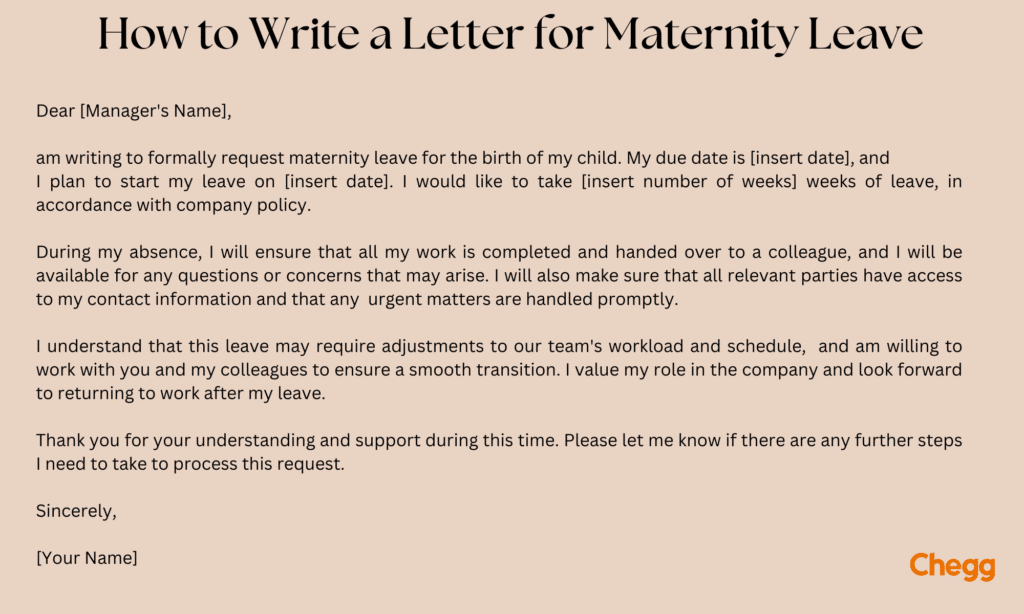

Quick Summary
- Maternity Leave is time off from work given to a mother to care for a newborn child.
- Pregnant women can take up to eight weeks of leave before their expected delivery date.
- The employee should have worked for at least 80 days in the 12 months preceding the expected delivery date. This is the foremost norm for eligibility for maternity leave in India.
Table of Contents
Maternity Leave is a vital period that allows new mothers to bond with their babies, recover from childbirth, and adjust to the responsibilities of motherhood. It is a time to prioritize your well-being and ensure a smooth transition into this new phase of life. Writing a well-crafted letter for maternity leave is an essential step in the process. It serves as a formal request to your employer, outlining the details of your intended leave and providing them with necessary information.
By submitting a letter for Maternity leave, you ensure compliance with company policies and demonstrate your professionalism and commitment to maintaining a harmonious work environment.
In this guide, we will walk you through the process of writing a letter for maternity leave, providing you with a proper format and a sample letter. You will learn how to effectively communicate your need for leave, specify the duration, and address any relevant concerns. Crafting a clear and concise letter will help you secure a smooth transition during your absence, enabling you to focus on the joys and responsibilities of motherhood.
Related Read: Paternity Leave Application
How to Apply for Maternity Leave?
If you are an expectant mother and wish to take advantage of your company’s maternity leave policy, it is important to follow the proper steps to apply for the leave with the maternity leave letter. Here are some steps to help guide you through the process:
- Review Your Company’s Maternity Leave Policy: Before submitting a pregnancy leave application it is important to review your company’s policy on the subject. You can find this information in your employee handbook. Or you can speak to your HR. Understanding your company’s policy will help you determine how much time you are eligible for and what benefits you can get.
- Notify Your Employer: Informing your employer as soon as possible is important. Most companies require that you provide at least 30 days’ notice, although some may require more. You can do this by scheduling a meeting with your supervisor or by submitting a written notice that includes your letter for maternity leave.
- Complete Any Required Paperwork: Your company may require you to complete certain paperwork before submitting your letter for maternity leave. You may need to include medical certification forms and a certificate from your doctor. Be sure to fill out all required paperwork accurately and completely.
- Check Your Benefits: Depending on your company’s policy, you may be eligible for paid or unpaid maternity leave. If you are eligible for paid leave, determine how your benefits will be paid.
- Stay in Touch with Your Employer: Throughout your maternity leave, it is important to communicate with your employer. This way you will stay up-to-date on any important developments in your job.
By following these steps, you can make sure that your letter for maternity leave is carried out smoothly.

Why is it required for a Maternity Leave Application?
A maternity leave application is necessary for several reasons. First, it formalizes the employee’s request, helping the employer plan for the absence and ensuring that workloads are managed efficiently.
Submitting a written request, such as a letter for maternity leave, for leave also protects the employee by creating a clear record of the request, which can be vital in cases of dispute or misunderstanding regarding leave duration and benefits. Additionally, having a formal application ensures compliance with legal requirements and the company’s policies, such as those outlined in the Maternity Benefit Act, ensuring the employee receives the correct benefits and protections.
Letter Format for Maternity Leave Letters
Writing a good letter format for maternity leave to the employer is crucial for a smooth transition from and back into work. Also, a clear and professional letter ensures that your employer can make the necessary arrangements for your absence. Below is a pregnancy leave application in a letter format.
[Your Name]
[Your Address]
[Date]
[Employer’s Name]
[Company Name]
[Company Address]
Dear [Employer’s Name],
It is my pleasure to inform you that I am expecting a child. And the due date is [insert due date].
As per the company policy, I would like to request maternity leave for [insert number of weeks or months] beginning on [insert start date] and ending on [insert end date].
I have attached the necessary medical documents and this letter for your reference.
I understand that I am entitled to [insert company policy details] during my maternity leave. Also, I would request you to please inform me about any compensation-related benefits during this time.
Please let me know if any additional paperwork is required.
I am committed to ensuring a smooth transition while I am on leave, and will work with my team to ensure that all necessary work is completed.
Thank you for your understanding and support during this time. I look forward to returning to work after my maternity leave.
Sincerely,
[Your Name]

Sample Application for Maternity Leave
Writing a clear and concise application is very important. Here is a sample leave application for pregnancy.
Dear [Employer],
I am writing to request maternity leave as per company policy. My due date is [insert due date], and I would like to begin my leave on [insert start date] and return to work on [insert return date], if possible.
I understand that I am entitled to [insert number of weeks or months] of maternity leave, and I plan to use my sick time, vacation time, or short-term disability benefits, if eligible, to receive compensation during this time.
As required, I have attached any necessary medical certification forms. Please let me know if there are any additional forms or paperwork that I need to complete.
I also understand the importance of communicating with my supervisor and will be available by phone or email during my leave.
Thank you for considering my request for maternity leave.
Sincerely,
[Your name]
Also read: How to Request an Extension for Maternity Leave
Maternity Leave Act of 2017
The Maternity Benefit (Amendment) Act of 2017 was a landmark change in India’s labour laws. It extended the duration of paid maternity leave for women employed in the private sector from 12 weeks to 26 weeks. This law applies to women in establishments with 10 or more employees and protects mothers before and after childbirth. Not only does it cover biological mothers, but it also includes provisions for adoptive mothers and commissioning mothers (those having a child through surrogacy). Employers are required to provide paid leave and ensure job security during this period.
Tips to Write a Letter for Maternity Leave
Remember these few important pieces of information when writing a maternity leave application.
- Address the Right Person: Your letter for maternity leave should be addressed to your manager or anyone else in the organization who needs to know about your leave. Ensure you address the right person and include their full name and title in the application.
- Write the Purpose of the Application: Clearly state that you are applying for maternity leave and the dates you plan to take off. It’s a good idea to provide the exact start and end date.
- Write a Detailed Explanation: Provide a detailed explanation for why you are taking maternity leave. This can be a personal reason or a medical reason.
- Give Notice: Give your employer enough notice of your maternity leave. Ideally, you should provide your employer with your letter for maternity leave several weeks before your planned start date. This will help them to make arrangements to cover your absence.
- Offer to Help: Consider offering to help before you leave, by training or mentoring a replacement. Also, try to create a detailed handover document that explains all your responsibilities and tasks.
- Express Gratitude: Show gratitude for the opportunity to take leave. Also, express your willingness to return to work after your leave period.
- Follow up: Once your leave has been approved, follow up with your employer. This necessary step will ensure a smooth transition and re-entry into your position upon your return.
Can your employer deny your Maternity Leave Application?
Under most national and state laws, employers cannot deny maternity leave if the employee meets the eligibility criteria. In India, under the Maternity Benefit Act of 2017, denial of maternity leave could result in legal consequences for employers. Similarly, in countries like the U.S., the Family and Medical Leave Act (FMLA) protects employees, guaranteeing up to 12 weeks of unpaid, job-protected leave for eligible employees. Denial is generally illegal unless the employee fails to meet the required criteria, such as working for a company for a minimum period or failing to provide appropriate medical documentation.
Craft a Professional Maternity Leave Letter
In conclusion, applying for maternity leave from an employer is a crucial step for any expecting mother who is also a working professional. It allows you to take the time to care for your newborn and adjust to the new demands of motherhood without compromising your career or job security. By following the tips outlined in this article, you can ensure that your application is clear, professional, and effective, helping you enjoy a stress-free transition into motherhood while maintaining a positive relationship with your employer. Remember, planning and communicating your needs can go a long way towards creating a healthy work-life balance for you and your family.
Evaluate numerous career choices to choose the right career path for yourself. Dive into our guide on Career Advice.
Frequently Asked Questions FAQ’s
How do I tell my boss about maternity leave?
It is important to inform your boss immediately about your maternity leave. Schedule a meeting or send an email to discuss your plans and the duration of your absence. Be clear and professional, and provide a short explanation for your leave. Keep the communication open and positive.
When should I start my maternity leave?
The timing of maternity leave varies depending on factors such as your personal preference, health, job requirements, and financial situation. Generally, it’s best to start your maternity leave a few weeks before your due date to give yourself time to prepare and rest before the baby arrives.
When should I inform my HR about maternity leave?
It’s recommended to inform your HR about your intention to take maternity leave as early as possible, typically around the 20-week mark. This allows your employer to make arrangements for your absence and protect your rights under relevant legislation. It’s also good to discuss your entitlements and any queries you may have.
How do you write a maternity leave email?
When writing a maternity leave email, write your intention to take leave and your expected start and end dates. Provide details of your plans for work handover and assure your employer of your commitment to a smooth transition. Be clear on the length of your leave and any return-to-work plans.
To read more related articles, click here.
Got a question on this topic?